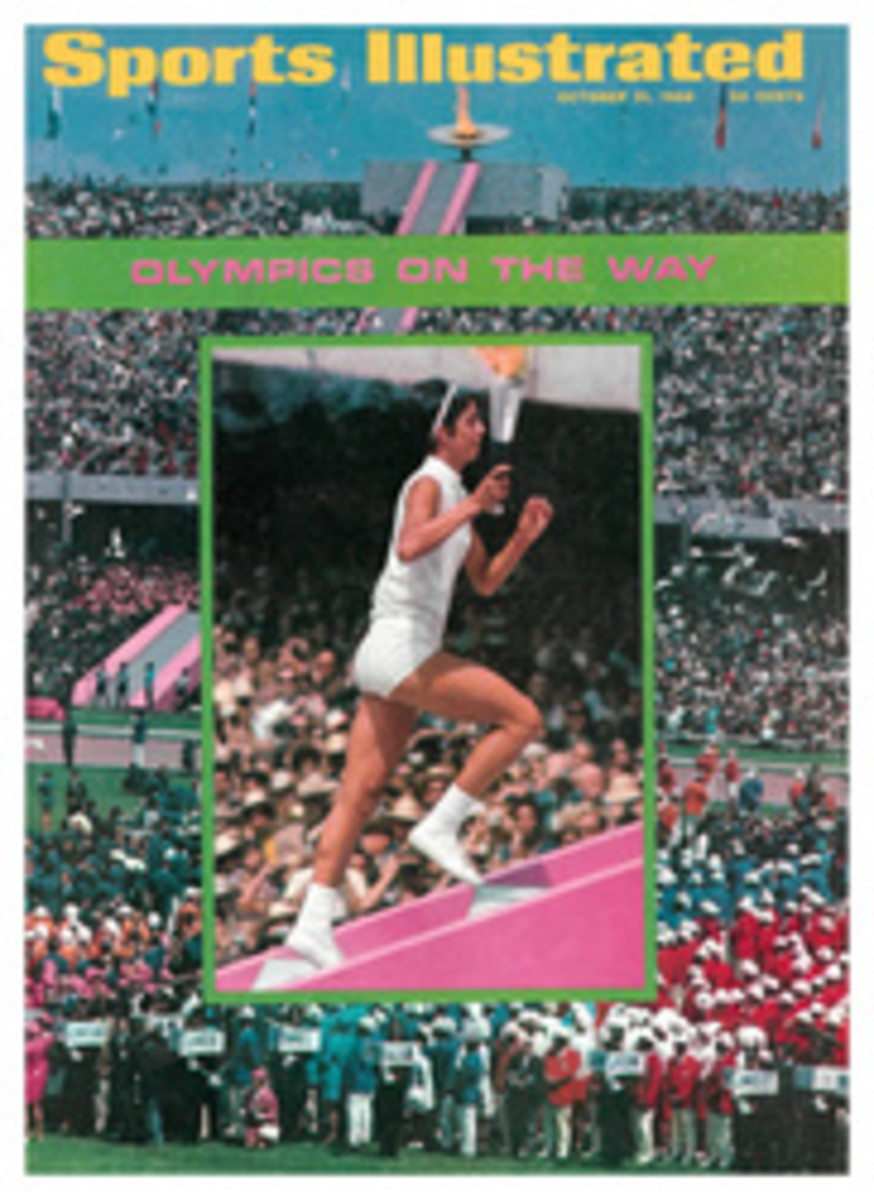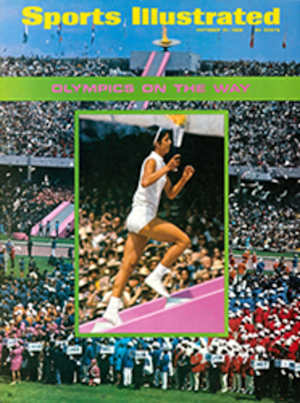
The great Michigan muddle
The thing about Mario Andretti is that in addition to being a pretty fair driver he is also a tenacious little guy. That is the main reason why, after a seven-month struggle, he holds the lead, however shakily, in the 1968 national big-car championship after last Sunday's 250-mile event on an ambitious new track, the Michigan International Speedway.
Andretti did not win the race—that surprise honor and $17,000 went to Ronnie Bucknum, a 32-year-old Californian better known for his sports car driving than his efforts in these Indy cars—and when the checkered flag fell he was not even second. The runner-up spot went, briefly, to a car co-driven by Mike Mosley and Bobby Unser, until last week the championship point leader.
But the race, or in this case even second place, is not always to the swift; occasionally the meticulous come through, and when Andretti and Crew Chief Clint Brawner rechecked the scoring sheets, they figured Andretti had finished second. Brawner put up the $100 necessary to protest the order of finish. Chief Steward Harry McQuinn took a look at the official electronic tapes, and McQuinn agreed with Brawner. He placed Andretti second and Mosley-Unser third, which did nothing to console Unser. He, in turn, protested the Andretti protest, at which point the officials gave up—another driver had also lodged a complaint against the posted order of finish—and sent everything back to Indianapolis for further checking.
All of this served to overshadow Bucknum's steady drive and well-deserved victory, which he won at an average speed of 163.043 mph, and the fact that the Michigan facility didn't waste any time coming of age despite a couple of first-race snags. For one, there was a monumental traffic jam coming and going, caused by the 55,000 paying customers and by several thousand more people who had intended to see the race but never got farther than a place called Cambridge Junction, a stoplight about half a mile away from the track.
The speedway is located just south of the town of Jackson in an area of soft, rolling land and quiet lakes known as the Irish Hills (four-leaf clovers were among the promotional gimmicks) just 67 miles from downtown Detroit. It is an easy drive from the test tracks of GM, Ford and Chrysler. More important, it is the only superspeedway in the Midwest outside of Indianapolis—which, of course, confines its activity to the Memorial Day 500. That only serves to whet the racing appetites of fans in the heavily populated areas of southern Michigan, Ontario, northern Ohio, Indiana and Illinois. Besides the big Sunday crowd, another 30,000 watched Saturday's practice and qualifying session, a crowd that most promoters would be satisfied with on race day.
The track was conceived early in 1966 by a group headed by a Detroit real-estate planner, Larry LoPatin. He bought up 800 acres of land, hired Charles Moneypenny of Daytona Beach, Fla. to do the major design work and asked former driver Stirling Moss to lay out a three-mile road circuit that, as Moss tells it, would "combine the southern Michigan countryside with downtown Detroit."
LoPatin broke ground last fall and, gambling on a break from the weather, scheduled Sunday's 250-mile U.S. Auto Club race. It was a tribute to modern technology and a whopping chunk of payroll overtime that the track was completed just about the time the race began.
The race was exciting enough in itself; the fact that Unser and Andretti were joined in battle for the USAC point championship was just so much frosting. To Mario, of course, the thing was an old story. In 1965 he had won the title. He repeated the following year, then fell back last season as A. J. Foyt took his fifth championship.
This year it looked as though Andretti and everybody else would again be outsiders. After the first five races of the season, including the Indy 500, Unser had four wins and more than 2,000 points, while Andretti was winless and had less than 500 points. After the 500, though, Bobby's luck changed and he was hit with a rash of chassis and engine problems and a series of spectacular crashes. The 500 was championship event No. 5; the MIS event was No. 25. In between, Unser had managed just one more victory—the Pikes Peak Hill Climb, which he won for the ninth time in 13 years—while Andretti set some sort of record for both doggedness and frustration by winning four races and finishing second eight times. Slowly, the margin Unser had built so rapidly shrank to 163 points.
Both drivers were a bit bland about their rivalry. As the 500 champ, Unser could well afford to be loose. Andretti remarked wistfully, "I would trade three national championships for a 500 win."
A mild case of the yips permeated the driving ranks at MIS, as usually happens at the opening event of any racetrack. Everybody knew this one would be fast; in tire tests Gordon John-cock (for Goodyear) and Andretti (for Firestone) had lapped the two-mile oval at better than 182 mph. Besides the high speeds, the cornering forces that the 18° banked turns exerted on the cars' suspension pieces were a part of the weekend's conversation and worry.
"At Indianapolis," one young driver said, "they make rookies go through all that rigmarole, and then you've got 30 days to get used to 165 mph; here they give you five hours to learn how to drive at 180."
Lloyd Ruby, a 12-year veteran of the big cars, said, "This is a nice racetrack—to drive on by yourself." And even Bobby Unser showed some apprehension when he said, "This will be a good one if everything holds together."
During the week of the race the Exponent, a paper published in Brooklyn, Mich., the nearest community to MIS, ran a picture of racing cars captioned with the old Irish blessing, "And may God hold you in the hollow of His hand."
For a while on Saturday, the only day of practice allowed, it was a crowded hollow. Bobby's younger brother Al put the first official dent on the track wall when he lost a wheel. Then Jim Malloy brushed the wall in the No. 2 turn, and Johncock, who had more than 700 miles of testing at the track, simply moved into the first turn too deep during his qualifying trial. The rear end broke loose, Johncock overcorrected and his racer went into a lazy spin at about 165 mph and wound up against the outside wall, too damaged to make the race.
But for Andretti and Unser everything went smoothly. Through the luck of the draw Mario qualified immediately before Bobby, and they wound up next to each other on the first row—Andretti on the pole with an average speed of 183.67 mph. Unser was just .46 second behind, despite having to use his backup car after he had burned a piston in his first one, and despite running without the front-end spoilers used on nearly every other race car to help keep the front end occasionally in touch with the track.
Although there were no serious mishaps during the race—the only contender was a first-lap brush between Roger McCluskey and Mac Dudley—the track did take its toll of machinery. Only 11 of the 26 starters were running at the finish, and only Bucknum, Unser and Andretti were anywhere near contention at the end.
Andretti, in fact, was lucky to finish. With superior horsepower, Unser built a steady lead over his rival. Then, on the 67th lap of the 125-lap race Mario coasted slowly into the pits from about a mile out. Engine trouble? Blown tire? Nothing like that. He was out of gas. His crewmen had calculated he could run at least 70 laps on the full load he had begun the race with; they missed by two, and Andretti lost 90 seconds, or nearly 2½ laps, by failing to come in for fuel earlier.
That left the track clear for Unser, but, as his first car had in practice, his backup car blew its engine on the main straight after 76 laps. Unser parked it at the end of the pit and ran over to flag in the car of his teammate, Mike Mosley, which, due to the attrition, was now in the lead. Unser simply requisitioned Mosley"s car, a move condoned because of an archaic and foolish USAC rule that allows a copilot to share a starting driver's championship points on a prorated basis.
The propriety of the rule is dubious at best. The driving title for 1967 was decided in the season's last race when A. J. Foyt crashed in the Rex Mays 300 at Riverside, Calif., hopped into Roger McCluskey's car and drove it long enough to get the points necessary for his fifth championship.
Even so, Unser's strategy did not preserve his lead. Second place was worth 400 points to Andretti and put him slightly ahead. With just three races left, Mario's lead over Unser is 139 points (assuming the order of finish as of Sunday night is upheld), 3,538 to 3,399. By jumping cars Unser picked up 98 points. The biggest loser of all was Mosley, a 23-year-old in his second championship season, who probably could have held on to win. It would have been his first victory. During the exchange of cars Unser, who is 6 feet even, had difficulty adjusting to Mosley's car. Mosley is 5'7", and the seat had been tailored for him.
Andretti said pragmatically, "It's in the rulebooks, and I would do it myself. But I don't like the rule.
"Besides, I'm a little guy [5'6"]. I can't just get into any car."
PHOTO

